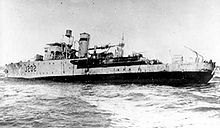HMAS Warrnambool (J202)
 HMAS Warrnambool in 1941 before being commissioned.
| |
| History | |
|---|---|
| Namesake | City of Warrnambool, Victoria |
| Builder | Morts Dock & Engineering Co in Sydney |
| Laid down | 13 November 1940 |
| Launched | 8 May 1941 |
| Commissioned | 23 September 1941 |
| Motto | "Protect And Avenge" |
| Honours and awards |
|
| Fate | Sunk during mine clearance on 13 September 1947 |
| Badge |  |
| General characteristics | |
| Class and type | Bathurst-class corvette |
| Displacement | 650 tons (standard), 1,025 tons (full war load) |
| Length | 186 ft (57 m) |
| Beam | 31 ft (9.4 m) |
| Draught | 8.5 ft (2.6 m) |
| Propulsion | triple expansion engine, 2 shafts |
| Speed | 15 knots (28 km/h; 17 mph) at 1,750 hp |
| Complement | 85 |
| Armament |
|
HMAS Warrnambool (J202), named for the city of
Design and construction
In 1938, the
Operational history
Warrnambool began her career with patrols of Bass Strait, before heading to northern waters.
In late 1942, the corvette moved to the east coast of Australia, where she remained until September 1944, performing convoy escort and anti-submarine patrols.

Following the conclusion of World War II, Warrnambool performed mine clearance work in the Solomon and New Guinea Islands before moving to the Great Barrier Reef.[1] While performing clearance work on 13 September 1947, the corvette hit a mine around 16:00 near Cockburn Reef, off the northern Queensland coast.[1][10] Four sailors were killed and another 29 were injured.[10] Warrnambool sank shortly afterward, in 25 metres (82 ft) of water.[1] The wreck was sold to Southern Cross Diving and Salvage on 3 July 1972.[1] A Board of Inquiry found that there was no culpable negligence in the loss of the corvette, and praised the conduct of her crew and commanding officer.[10][11] Warrnambool is the only RAN ship to be sunk by a mine.[12] A survey conducted in 2016 by HMAS Mermaid found that the wreck of Warrnambool remained largely intact.[13]
The corvette's wartime service was recognised with three battle honours: "Darwin 1942", "Pacific 1942–45", and "New Guinea 1942".[14][15]
Citations
- ^ a b c d e f g h i j k l m n o p "HMAS Warrnambool (I)". Sea Power Centre Australia. Retrieved 15 September 2008.
- ^ a b c Stevens, The Australian Corvettes, p. 1
- ^ Stevens, A Critical Vulnerability, p. 103
- ^ Stevens, A Critical Vulnerability, pp. 103–4
- ^ Stevens, A Critical Vulnerability, pp. 103–5
- ^ Stevens, A Critical Vulnerability, p. 104
- ^ Stevens, A Critical Vulnerability, pp. 105, 148
- ^ Donohue, From Empire Defence to the Long Haul, p. 29
- ^ Stevens et al., The Royal Australian Navy, p. 108
- ^ a b c Morley, Dave (12 September 2013). "Corvette's final sweep". Navy News. p. 16.
- ^ "Warrnambool Inquiry Clears Captain and Crew". The Canberra Times. National Library of Australia. 30 October 1947. p. 4. Retrieved 7 April 2015.
- OCLC 50418095.
- ^ "HMAS Mermaid visits old friend to test new technology". Navy Daily. Royal Australian Navy. Archived from the original on 21 March 2016. Retrieved 20 March 2016.
- ^ "Navy Marks 109th Birthday With Historic Changes To Battle Honours". Royal Australian Navy. 1 March 2010. Archived from the original on 13 June 2011. Retrieved 23 December 2012.
- ^ "Royal Australian Navy Ship/Unit Battle Honours" (PDF). Royal Australian Navy. 1 March 2010. Archived from the original (PDF) on 14 June 2011. Retrieved 23 December 2012.
References
- Books
- Donohue, Hector (October 1996). From Empire Defence to the Long Haul: post-war defence policy and its impact on naval force structure planning 1945–1955. Papers in Australian Maritime Affairs. Vol. 1. Canberra: Sea Power Centre. OCLC 36817771.
- Stevens, David (2005). A Critical Vulnerability: the impact of the submarine threat on Australia's maritime defense 1915–1954. Papers in Australian Maritime Affairs. Vol. 15. Canberra: Sea Power Centre Australia. OCLC 62548623.
- Stevens, David; Sears, Jason; Goldrick, James; Cooper, Alastair; Jones, Peter; Spurling, Kathryn (2001). Stevens, David (ed.). The Royal Australian Navy. The Australian Centenary History of Defence (vol III). South Melbourne, VIC: Oxford University Press. OCLC 50418095.
- Journal and news articles
- Stevens, David (May 2010). "The Australian Corvettes" (PDF). Hindsight (Semaphore). 2010 (5). Sea Power Centre – Australia. Archived from the original (PDF) on 20 March 2011. Retrieved 13 August 2010.
External links
